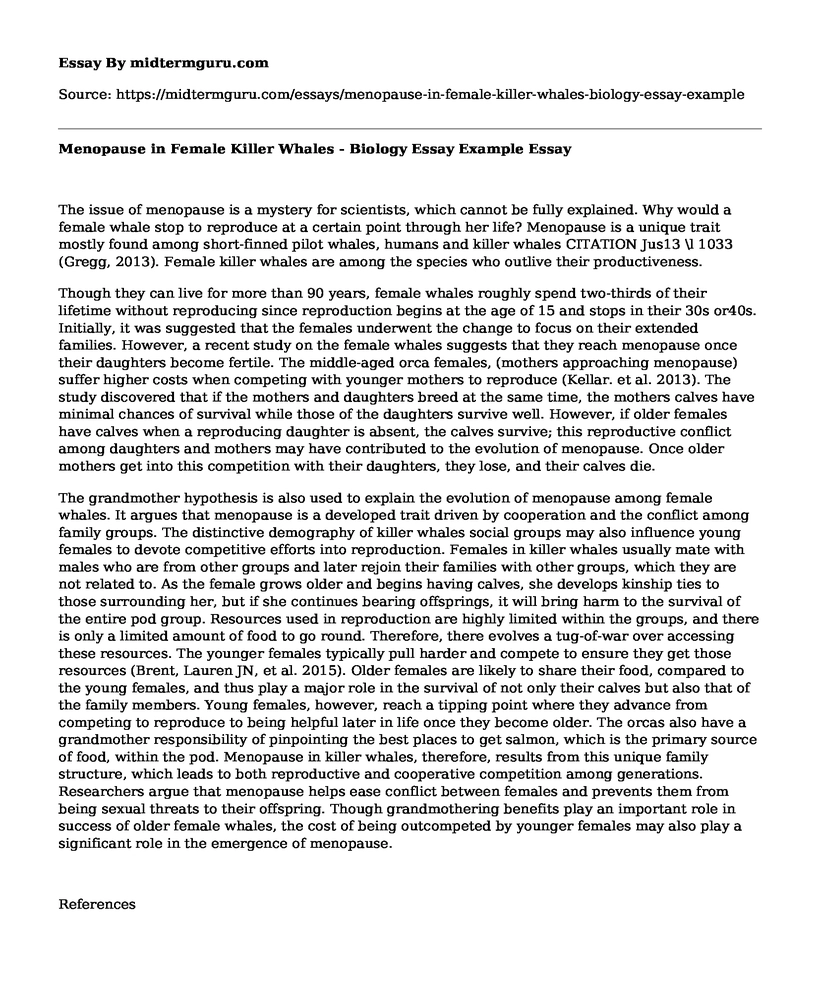The issue of menopause is a mystery for scientists, which cannot be fully explained. Why would a female whale stop to reproduce at a certain point through her life? Menopause is a unique trait mostly found among short-finned pilot whales, humans and killer whales CITATION Jus13 \l 1033 (Gregg, 2013). Female killer whales are among the species who outlive their productiveness.
Though they can live for more than 90 years, female whales roughly spend two-thirds of their lifetime without reproducing since reproduction begins at the age of 15 and stops in their 30s or40s. Initially, it was suggested that the females underwent the change to focus on their extended families. However, a recent study on the female whales suggests that they reach menopause once their daughters become fertile. The middle-aged orca females, (mothers approaching menopause) suffer higher costs when competing with younger mothers to reproduce (Kellar. et al. 2013). The study discovered that if the mothers and daughters breed at the same time, the mothers calves have minimal chances of survival while those of the daughters survive well. However, if older females have calves when a reproducing daughter is absent, the calves survive; this reproductive conflict among daughters and mothers may have contributed to the evolution of menopause. Once older mothers get into this competition with their daughters, they lose, and their calves die.
The grandmother hypothesis is also used to explain the evolution of menopause among female whales. It argues that menopause is a developed trait driven by cooperation and the conflict among family groups. The distinctive demography of killer whales social groups may also influence young females to devote competitive efforts into reproduction. Females in killer whales usually mate with males who are from other groups and later rejoin their families with other groups, which they are not related to. As the female grows older and begins having calves, she develops kinship ties to those surrounding her, but if she continues bearing offsprings, it will bring harm to the survival of the entire pod group. Resources used in reproduction are highly limited within the groups, and there is only a limited amount of food to go round. Therefore, there evolves a tug-of-war over accessing these resources. The younger females typically pull harder and compete to ensure they get those resources (Brent, Lauren JN, et al. 2015). Older females are likely to share their food, compared to the young females, and thus play a major role in the survival of not only their calves but also that of the family members. Young females, however, reach a tipping point where they advance from competing to reproduce to being helpful later in life once they become older. The orcas also have a grandmother responsibility of pinpointing the best places to get salmon, which is the primary source of food, within the pod. Menopause in killer whales, therefore, results from this unique family structure, which leads to both reproductive and cooperative competition among generations. Researchers argue that menopause helps ease conflict between females and prevents them from being sexual threats to their offspring. Though grandmothering benefits play an important role in success of older female whales, the cost of being outcompeted by younger females may also play a significant role in the emergence of menopause.
References
BIBLIOGRAPHY Gregg, J. (2013). Are Dolphins Really Smart?: The Mammal Behind the Myth. London: OUP Oxford.
Brent, L. J., Franks, D. W., Foster, E. A., Balcomb, K. C., Cant, M. A., & Croft, D. P. (2015). Ecological knowledge, leadership and the Evolution of Menopause in killer Whales. Current Biology, 25(6), 746-750.Kellar, N. M., Keliher, J., Trego, M. L., Catelani, K. N., Hanns, C., George, J. C., & Rosa, C. (2013). Variation of bowhead whale progesterone concentrations across demographic groups and sample matrices. Endangered Species Research, 22(1), 61-72.
Cite this page
Menopause in Female Killer Whales - Biology Essay Example. (2021, Jun 08). Retrieved from https://midtermguru.com/essays/menopause-in-female-killer-whales-biology-essay-example
If you are the original author of this essay and no longer wish to have it published on the midtermguru.com website, please click below to request its removal:
- Reflection of the Patient During Practicum Experience: Gastroesophageal Reflux Disease
- Cognitive Science: Exploring the Problem of Cognition - Paper Example
- Discussion on Environmental Services on Areas That Inhibit the Growth of Bacteria - Paper Example
- Paper Example on Microbiology
- Human Adaptation to Climate: Annotated Bibliography
- Memory, Learning, Creativity and Intelligence Interrelation - Essay Sample
- Biotech: Unlocking Biological Processes for Industrial Use - Essay Sample







